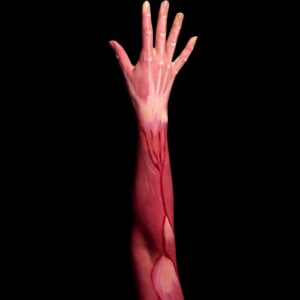
Delayed Onset Of Muscle Soreness (DOMS) is a general problem due to intense workouts after prolonged periods of immobilization. It is characterized by muscle pain, stiffness, and tenderness, which typically begin 24 to 48 hours after exercise and can last for many days.

DOMS involves microscopic damage to the muscle fibers, which triggers an inflammatory response, leading to pain and
stiffness.
DOMS is a typical and expected response to exercise, particularly if the activity involves eccentric muscle contractions. DOMS is a common and typically self-limiting condition that can be managed with appropriate self-care strategies.
However, if the pain and stiffness are severe or do not improve with self-care measures, seeking medical attention to rule out any underlying injuries or conditions is crucial. There are general strategies that can be used to alleviate the symptoms of DOMS, including rest and recovery, massage, stretching, ice or heat therapy, and over-the-counter pain relievers.
Delayed Onset Of Muscle Soreness is a common and usually self-limiting condition that can be managed with appropriate self-care strategies. However, the pain and stiffness are severe or do not improve with self-care measures. In that case, seeking medical attention to rule out any underlying injuries or conditions is essential.
Read More: Along with Text Neck Disorder And Mobile Phone Addiction 2023 Read more about How Mobile Phones Cause Neck Pain
Table of Contents
Skeletal Muscles Of the Body – Delayed Onset Of Muscle Soreness

Skeletal muscles are voluntary muscles of the body. They attach to bones via tendons and help in body movements and activities. The second name of these muscles is striated muscles. Striations are visible in the microscopic view of these muscles.
Skeletal muscles are formed by long, cylindrical fibers that are bundled together and surrounded by connective tissue.
These fibers contain many smaller fibers called myofibrils, which are composed of even smaller units called sarcomeres.
Sarcomeres are responsible for the contraction of the muscle fibers, allowing for movement. Contractions of these voluntary muscles enable movement of bones and articulations at joints.
Skeletal muscles are under conscious control and are typically attached to bones by tendons. Contractions of these voluntary muscles bring the movement of bones and joint play at joints. Some examples of skeletal muscles include those in the arms, legs, back, and abdomen.
Examples:
- Deltoid muscle
- Biceps brachii muscle
- Triceps brachii muscle
- Flexor carpi radials muscle
- Extensor carpi radials muscle
- Trapezius muscle
- Lower limb muscles:
- Gluteus maximus muscle
- Quadriceps muscles
- Hamstrings muscles
- Gastrocnemius muscle
- Tibialis anterior muscle
- Soleus muscle
What Are the Types Of Skeletal Muscles

Type I or (Slow-Twitch): These muscles are also called slow oxidative (SO) fibers. They are designed for endurance activities that require sustained contractions over a long period, such as distance running or cycling. They are highly resistant to fatigue and can maintain a low level of force for an extended period.
Type IIa or (Fast-Twitch): These muscles are called fast oxidative-glycolytic (FOG) fibers. Oxidative and glycolytic metabolisms are produced in these muscles for energy production, which means they can create energy quickly and sustain it for reasonable periods. They are used in activities that require a combination of strength and endurance, such as middle-distance running or swimming.
Type IIb or (Fast-Twitch): These muscles are called fast glycolytic (FG) fibers. They are designed for short bursts of intense activity, such as sprinting or weightlifting. They can produce energy quickly but fatigue rapidly.
It’s important to note that most muscles are a mixture of these fiber types, but the proportion of each type can vary depending on the muscle’s function and the individual’s genetics and training.
How Muscles Respond To Exercise

When you exercise, your muscles undergo several physiological changes that allow them to adapt and become stronger. Here are some of the critical ways that muscles respond to exercise:
Muscle fibres are damaged: When you perform the exercise, particularly resistance training, you cause small micro-tears in the muscle fibers. This damage triggers muscle protein synthesis, which helps repair and rebuild the muscles to be stronger and more resilient.
Muscle fibres become larger: Regular exercise can cause muscle fibers to grow in size, a process called hypertrophy. This is particularly true of type II muscle fibres responsible for power and strength.
Increased blood flow: During exercise, blood flow to the muscles increases to provide them with the oxygen and nutrients they need to perform. Increased blood flow washes out fatigue, causing agents from muscles.
Improved neuromuscular coordination: Regular exercise can improve neuro-muscular coordination, making them more efficient and effective at performing tasks.
Increased endurance: Endurance exercise, like running or cycling, can lead to adaptations in the muscle fibres that make them better able to use oxygen and produce energy, leading to increased endurance.
Delayed Onset Of Muscle Soreness [DOMS]
Whenever we exercise, our muscles respond to this physical exertion within 24 to72 hours via pain and inflammation, called the Delayed Onset Of Muscle Soreness.
Sign and Symptoms of Delayed Onset Of Muscle Soreness
Delayed Onset Of Muscle Soreness is often accompanied by a
- Dull, aching pain of muscles tissues that were worked, along with
- Stiffness,
- Tenderness, and
- Reduced range of motion.
Delayed Onset Of Muscle Soreness is a normal part of the muscle repair process and is commonly experienced by people new to exercise and experienced athletes who push themselves to the limit.
DOMS is thought to be caused by tiny tears in the muscle fibers that occur during exercise, particularly during eccentric contractions (when a muscle lengthens while under tension). These small tears can lead to inflammation, which in turn can cause pain and stiffness. However, despite its name, DOMS still needs to be fully understood, and there is still debate about its exact causes.
The treatment strategies include rest, gentle stretching, massage, foam rolling, and over-the-counter pain medication. It is also essential to rest, so the muscles can recover before exercising again, aspushing through the pain can exacerbate Delayed Onset Of Muscle Soreness and increase the risk of further injury.
Literature Supports the Pathogenesis of Delayed Onset Of Muscle Soreness
Pathogenesis of DOMS: Delayed Onset Of Muscle Soreness is caused by microscopic damage to muscle fibers from unaccustomed or strenuous physical activity. pathogenesis of DOMS is thought to involve a complex interplay of various mechanisms, including mechanical, metabolic, and inflammatory factors.[1]
Mechanical Factors: One of the leading causes of Delayed Onset Of Muscle Soreness is believed to be mechanical stress or damage to muscle fibres. This mechanical damage can occur during eccentric contractions, which involve the lengthening of a muscle while under tension, such as during downhill running or weightlifting exercises. The mechanical damage to muscle fibres can trigger a cascade of events, including inflammation and muscle remodeling. [1]
Metabolic Factors: During strenuous physical activity, muscles undergo significant producing lactic acid, reactive oxygen species (ROS), and other metabolites. These metabolites can lead to oxidative stress and mitochondrial dysfunction, contributing to developing DOMS. [1]
Inflammatory Factors: Inflammation is a critical component of the pathogenesis of DOMS. The mechanical and metabolic factors that contribute to muscle damage trigger an inflammatory response, which can lead to the release[1]
Diagnostics of Delayed Onset Of Muscle Soreness
There is no definitive diagnostic test for DOMS; diagnosis is typically based on clinical signs and symptoms. However, several biomarkers have been proposed as potential diagnostic tools for DOMS. One promising biomarker is creatine kinase. [1]
One theory suggests that DOMS is caused by microtrauma and inflammation in the muscle fibres. This microtrauma can occur during eccentric muscle contractions, which involve the lengthening of a muscle while under tension. The microtrauma triggers an inflammatory response, which leads to pain, stiffness, and reduced range of motion.
Another theory suggests that DOMS is caused by a disruption in the excitation-contraction coupling process within muscle fibres. This disruption can lead to calcium accumulation, oxidative stress, and the activation of inflammatory pathways, ultimately resulting in muscle damage and pain.
There are several methods for diagnosing DOMS, including subjective measures such as self-reported pain levels
and objective measures such as biomarkers in the blood. One promising biomarker is creatine kinase and lactate
dehydrogenase (LDH) [1] These Biomarkers are elevated in individuals experiencing DOMS. MRI can also be
performed to assess muscles injury and integrity.
Overall, advances in research have provided a better understanding of the pathogenesis and diagnostics of DOMS. This knowledge can inform the development of new treatments and strategies for preventing and managing DOMS in individuals who engage in physical activity.[2]
Treatment of Delayed Onset Of Muscle Soreness
One of the most effective treatments for DOMS is rest. This allows the body to recover and repair the damaged muscle fibers. In addition to rest, several other treatment strategies are effective, including massage, foam rolling, and stretching. These strategies can help to lessens flow of blood to injured part, reduce inflammation, and improve the range of motion. [2]
Another effective treatment for DOMS is using drugs, pain killers and NSAIDs to minimize the pain, swelling and inflammation.
Proper nutrition and hydration are essential for preventing DOMS. Adequate protein intake is necessary for muscle repair and recovery, while hydration helps to transport nutrients and remove waste products from the muscles. Finally, getting enough sleep and managing stress can also play a role in preventing DOMS by promoting overall health and wellness.
In summary, advances in research have provided a better understanding of effective treatment and prevention strategies for DOMS. By incorporating these strategies into their exercise routines, individuals can minimize the impact of DOMS and improve their overall fitness and health. [2]
The Study suggests that CWI performed on successive days effectively reduces muscle damage and inflammation in volleyball players without compromising physical performance. However, more research is needed to confirm these findings and to determine the optimal timing and duration of CWI for different types of exercise and sports.[3]
A study suggests that PBC and CWI can effectively reduce muscle soreness after female muscle damage. However, further research is needed to determine the optimal protocol for each type of treatment and assess the long-term effects of these treatments on recovery and performance.[4]
The Study suggests that dynamic contract-relax stretching can be an effective intervention for reducing DOMS among healthy individuals. This stretching type may help increase blood flow to the affected muscles, reduces inflammation, and improves the range of motion. However, further research is needed to determine the optimal protocol for dynamic contract-relax stretching and to assess its long-term effects on recovery and performance.[5]
The Study suggests that compression garments effectively reduce edema and muscle soreness in DOMS. These findings support using compression garments as a practical and non-invasive intervention for managing DOMS. However, more research is needed to determine the optimal timing and duration of compression garment use and the long-term effects on recovery and performance.[6]
Triathletes often experience exercise-induced muscle injuries during training and competitions, affecting their performance and recovery. It is important to consider strategies to accelerate recovery from these injuries and optimize performance for Olympic distance races.
Here are some considerations for triathletes to accelerate recovery from exercise-induced muscle injuries:
- Adequate rest: Adequate rest is crucial for recovery from exercise-induced muscle injuries. Triathletes should ensure they get enough sleep and rest between training sessions to allow their muscles to recover.
- Nutrition: Proper nutrition is essential for muscle recovery. Triathletes should consume adequate protein and carbohydrates to promote muscle repair and glycogen restoration. Antioxidant-rich foods, such as fruits and vegetables, can also help to reduce inflammation and oxidative stress.
- Cold-water immersion: Cold-water immersion (CWI) effectively reduces muscle soreness and accelerates recovery from exercise-induced muscle injuries. Triathletes can consider using CWI immediately after training or competitions to reduce inflammation and promote muscle recovery.
- Massage therapy: Massage therapy can help to promote circulation, reduce inflammation, and improve muscle flexibility, all of which can accelerate recovery from exercise-induced muscle injuries. Triathletes can consider incorporating regular massage therapy sessions into their training and recovery routines.
- Compression garments: Compression garments can help to reduce muscle soreness and accelerate recovery by promoting circulation and reducing inflammation. Triathletes can use compression garments during and after training or competitions to aid healing.
These strategies can help to optimize the flow of blood to the injured part, which reduce inflammation, improve
muscle health and the range of motion.
Cold Versus Heat Therapy For DOMS
Cold and heat therapy is commonly used to manage delayed onset muscle soreness (DOMS). Still, they have different mechanisms of action and may be more or less effective depending on the stage of DOMS. Here is a breakdown of the benefits and drawbacks of cold and heat therapy for DOMS:
| Benefits of Cold Therapy | Benefits of Heat Therapy |
| (i) Cold therapy (also known as Cryotherapy) can help to reduce inflammation, pain, and swelling by decreasing the diameter of blood vessels and lessening blood flow to the relevant area. (ii) It can also help to numb the site, providing temporary relief from pain. (iii) Cold therapy may be more effective in the early stages of DOMS when inflammation and swelling are most prevalent. | (i) Heat therapy (also known as thermotherapy) improves the flow of blood and oxygen to the affected part. (ii) It enhances healing and lowers muscle stiffness. (iii) It can also help increase muscle relaxation and flexibility, reducing pain and improving the range of motion. (iv) In contrast, heat therapy may be more effective in the later stages of DOMS, when muscle stiffness and pain are more prevalent. |
| Drawbacks of Cold Therapy | Drawbacks of Heat Therapy |
| (i) Cold therapy can cause excessive vasoconstriction which can limit blood flow and nutrients to the area and potentially slowing the healing process. It can also cause discomfort, mainly if applied for too long or at too cold a temperature | (i) Heat therapy can cause vasodilation, increasing inflammation and swelling in the early stages of DOMS. (ii) It can also cause discomfort if applied for too long or at too high a temperature. |
Preventions
In prevention, the gradual progression of exercise intensity and duration is critical. Overloading the muscles too quickly can lead to microtrauma and inflammation, resulting in DOMS. Incorporating a proper warm-up and cool-down routine, as well as stretching before and after exercise, can also help to prevent DOMS.
- Gradual Progression: Gradual progression is essential when starting a new exercise program or increasing the intensity or duration of exercise. This allows the muscles to adapt gradually to the increased demands, reducing the likelihood of DOMS.
- Warm-up and Cool-down: A proper warm-up and cool-down can help to prepare the muscles for exercise and reduce the likelihood of DOMS. An introduction should include dynamic stretching and low-intensity activity, while a cool-down should include static stretching and gentle movement.
- Hydration: Proper hydration is essential for muscle health and recovery. Dehydration can lead to muscle cramps and fatigue, increasing the likelihood of DOMS.
- Proper Nutrition: Proper nutrition is essential for muscle recovery and the prevention of DOMS. A diet rich in protein and carbohydrates can promote muscle repair and glycogen restoration.
- Recovery Techniques: Incorporating recovery techniques, such as massage therapy, foam rolling, and stretching, into a regular exercise routine can help to reduce muscle soreness and prevent DOMS.
- Adequate Rest: Adequate rest is crucial for muscle recovery and prevention of DOMS. Sufficient sleep and rest between training sessions allow the muscles to recover and adapt to exercise demands
- Proper Form and Technique: Using good form and technique during exercise can reduce the risk of muscle strain and injury, declining the risk of DOMS.
By incorporating these strategies into an exercise routine, individuals can prevent DOMS and optimize their muscle health and performance.
Summary
Delayed Onset of Muscle Soreness (DOMS) is a general condition in response to exercise, causing muscle pain and stiffness. Treatment strategies for DOMS include rest and recovery, massage, stretching, ice or heat therapy, and over-the-counter pain relievers. It is essential techniques may only alleviate symptoms and not necessarily prevent DOMS from occurring again in the future.
It is also necessary to seek medical attention if the pain and stiffness are severe or do not improve with self-care measures. DOMS is a typical and expected response to exercise, and appropriate self-care strategies can help manage its symptoms.
References – Delayed Onset Of Muscle Soreness
1. Hotfiel, T., et al., Advances in delayed-onset muscle soreness (DOMS): Part I: Pathogenesis and diagnostics. Sportverletzung· Sportschaden, 2018. 32(04): p. 243-250.
2. Heiss, R., et al., Advances in delayed-onset muscle soreness (DOMS)–part II: treatment and prevention. Sportverletzung· Sportschaden, 2019. 33(01): p. 21-29.
3. de Freitas, V.H., et al., Effect of cold water immersion performed on successive days on physical performance, muscle damage, and inflammatory, hormonal, and oxidative stress markers in volleyball players. The Journal of Strength & Conditioning Research, 2019. 33(2): p. 502-513.
4. Hohenauer, E., et al., Partial‐body cryotherapy (− 135 C) and cold‐water immersion (10 C) after muscle damage in females. Scandinavian journal of medicine & science in sports, 2020. 30(3): p. 485-495.
5. Xie, Y., et al., The efficacy of dynamic contract-relax stretching on delayed-onset muscle soreness among healthy individuals: A randomized clinical trial. Clinical Journal of Sports Medicine, 2018. 28(1): p. 28-36.
6. Heiss, R. et al., Effect of compression garments on developing oedema and soreness in delayed-onset muscle soreness (DOMS). Journal of sports science & medicine, 2018. 17(3): p. 392.

One Response